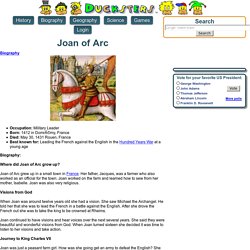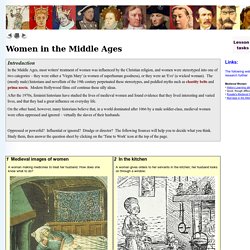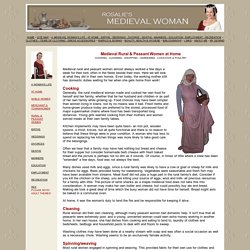

Joan of Arc for Kids. Biography Occupation: Military Leader Born: 1412 in Domrémy, France Died: May 30, 1431 Rouen, France Best known for: Leading the French against the English in the Hundred Years War at a young ageBiography: Where did Joan of Arc grow up?

Joan of Arc grew up in a small town in France. Her father, Jacques, was a farmer who also worked as an official for the town. Joan worked on the farm and learned how to sew from her mother, Isabelle. Visions from God When Joan was around twelve years old she had a vision. Joan continued to have visions and hear voices over the next several years. Journey to King Charles VII Joan was just a peasant farm girl. Joan met with the king. While Joan waited on the king, she practiced for battle. Siege of Orleans News of Joan's visions from God reached Orleans before she did. Joan had to wait for the rest of the French army to arrive. Middle Ages for Kids: Famous Queens. History >> Biographies >> Middle Ages for Kids The Middle Ages was a time of kings, princes, castles, knights, and lords.

Although women weren't officially allowed by the church to be leaders or monarchs, many women still held power. A few even became monarchs and led their countries. Here are a few of the most famous queens from medieval times. Good Queen Maude (1080 - 1118) Good Queen Maude was also known as Matilda I of Scotland. Empress Matilda (1102 - 1167) Matilda was married to Henry V the Holy Roman Emperor. Digging Deeper Item KS3 - The Middle Ages - The family. The family In the Middle Ages it was very unusual for people to choose what sort of work they did, whom they married, or how they were educated.

These things depended on the sort of family each person belonged to, and they were very difficult to change. Poor peasant families had a very different way of life from the families of knights, noblemen or townspeople. Growing up Babies were baptized soon after birth since many died of disease in the first days of life.
Surnames The surnames of wealthy families were often taken from the name of the most important part of their lands. Key Stage 3 at www.johndclare.net. Introduction In the Middle Ages, most writers' treatment of women was influenced by the Christian religion, and women were stereotyped into one of two categories – they were either a 'Virgin Mary' (a women of superhuman goodness), or they were an 'Eve' (a wicked woman).

The (mostly male) historians and novellists of the 19th century perpetuated these stereotypes, and peddled myths such as chastity belts and prima nocta. Modern Hollywood films still continue these silly ideas. After the 1970s, feminist historians have studied the lives of medieval women and found evidence that they lived interesting and varied lives, and that they had a great influence on everyday life.
On the other hand, however, many historians believe that, in a world dominated after 1066 by a male soldier-class, medieval women were often oppressed and ignored – virtually the slaves of their husbands. Medieval Women. Medieval England was not a comfortable place for most women.

Medieval women invariably had a hard time in an era when many men lived harsh lives. A few women lived comfortable lives but Medieval society was completely dominated by men and women had to know ‘their place’ in such a society. Medieval society would have been very traditional. Women had little or no role to play within the country at large. Rosalie's Medieval Woman - Rural at home.
Medieval Rural & Peasant Women at Home COOKING - CLEANING - SHOPPING - GARDENING - LIVESTOCK & POULTRY Medieval rural and peasant women almost always worked a few days a week for their lord- often in the fields beside their men.

Here we will look at what they did in their own homes. Even today, the working mother still has domestic duties waiting for her when she gets home from work! Cooking Generally, the rural medieval woman made and cooked her own food for herself and her family, whether that be her husband and children or as part of her own family while growing up. Food choices may have been simpler than women living in towns, but by no means was it bad. Kitchen implements may have been quite basic- an iron pot, wooden spoons, a trivet, knives, but all quite functional and there is no reason to believe that these things were in poor condition. Rosalie's Medieval Woman - Nobles at home. Medieval Noble Women at Home COOKING - CLEANING - SHOPPING - GARDENING - LIVESTOCK & POULTRY The noble woman was nothing short of amazing.

As well as managing a household, she was required to have many of the skills that a regular woman had in order to instruct her staff. Her home duties included hiring and firing staff, overseeing orders for the pantry and buttlery, checking quality of foodstuffs, fabrics and the prices of them, and a variety of tasks on behalf of her husband. Cooking A noble woman neither did the cooking for her household herself nor did she wait on tables. Even female servants did not bring food to the tables and manuscripts almost always show men cooking in the kitchens and preparing food. Cleaning It goes without saying that the cleaning in a noble woman's house was also not done by a noble woman. Shopping Livestock/Poultry Aagain, this was not the domain of the wealthy woman who hired the staff neccessary to look after any animals.
Child raising Wet nurses.